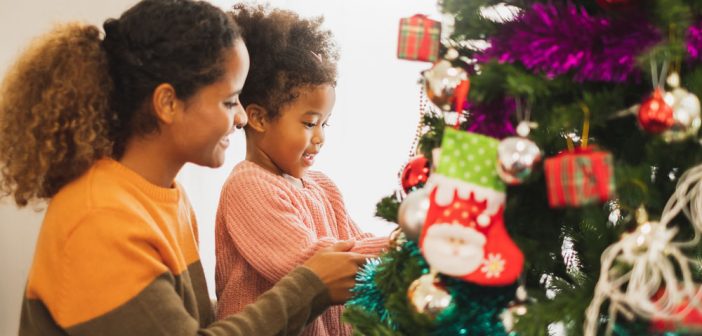Christmas is a holiday rich with tradition. From Christmas trees to Nativity Scenes, here’s a look at some of the most popular and enduring ways we celebrate the season:
Christmas Trees
For millennia, the evergreen fir has been used to celebrate all manner of winter festivities. When, exactly, the evergreen was first used to celebrate Christmas is unclear, but experts guess it was likely about 1000 years ago in northern Europe. The Christmas Tree remains one of the holiday’s most enduring and potent symbols.
Mistletoe
In Norse mythology, mistletoe was used to express friendship and/or love. Today, stealing a kiss beneath a sprig of mistletoe has become a beloved Christmas tradition.
Poinsettias
According to a Mexican Christmas legend, a young girl was sad because she had no gift to present to the baby Jesus. She gathered some plants she saw on the side of the road, hoping Jesus would appreciate that they were offered with love. When she presented the plants, they miraculously blossomed into beautiful red poinsettia flowers.
Christmas Cards
Believe it or not, the much-loved custom of sending Christmas cards actually began as a deliberate ploy to get common people to use the UK’s new “Public Records Office,” later renamed the post office.
Christmas Bells
Because of their use in, and association with, churches, bells have long been associated with celebrating Christmas. During Victorian times, tuned hand-bells became popular among carolers, a trend that has regained popularity today.
Carols
Christmas songs have been around since at least the second century, and they continue to be a large part of holiday celebrations all over the world.
Christmas Turkey
When Queen Victoria included Turkey in her Christmas dinner, it quickly became a trend, one that endures to this day.
Red, Green, and Gold
The colors we associate with Christmas are vibrant and festive, but did you know that each color is representative of something to do with the holiday? Green represents the color of the evergreen tree; red symbolizes both holly berries and the robes worn by Bishops (including Saint Nick); gold represents the star followed by the Magi and one of the gifts given to the baby Jesus.
Candy Canes
Candy canes have been associated with Christmas since 1874. The candy cane is said to represent a shepherd’s staff, though this association was likely made in hindsight.
Presents
The giving of gifts at Christmastime is a nod to the Magi (or Wise Men) who traveled to see the infant Jesus. The Wise Men were said to have brought the Child gifts of Gold, Frankincense, and Muhr.
Nativity Scenes
According to the Gospels, Jesus was born in a manger in Bethlehem. That the King of Kings should have so inauspicious a beginning was central to His message, and Nativity Scenes depicting Christ’s birthplace are still used to celebrate Christmas.
Candles
Christmas celebrations during the Middle Ages used a large candle to represent the star that appeared in the sky when Christ was born. This is the first example of a specific association between candles and Christmas.
Holly and Ivy
Holly and Ivy make beautiful decorations for the holidays, but they also have symbolic meaning. Ivy only grows upon something that can support it. This represents man’s relationship with God. Holly is known in Scandinavia as the “Christ Thorn,” as its leaves resemble a crown of thorns. The red berries in the middle are symbolic of droplets of Christ’s blood.
Christmas Pudding
The custom of eating a Christmas pudding with dinner dates back to 14th century Brittain. Originally it was more of an oatmeal-like soup containing raisins, mutton, and wine, among other things. By the late sixteenth century, the preferred pudding became plum.
Santa Clause/Saint Nick
The idea of a Christmas gift-giver is one embraced by children the world over. Though Santa Claus, or Saint Nick, is the most popular, there are a host of these benevolent givers. In some cultures, for example, it is the Wise Men who bring gifts to good boys and girls. In others, it is the baby Jesus.
The Yule Log
The burning of a yule log is originally a Nordic tradition that eventually spread throughout Europe and finally to the Americas.
The Star of Bethlehem
When Christ was born, a new star appeared in the sky over Bethlehem. The three Wise Men used this star as a navigational marker to lead them to the new King.
Elf on the Shelf
Easily the newest tradition on our list, the Elf on the Shelf has nonetheless found a place for himself in the Christmas lexicon. The Christmas toy, based on a 2005 book written by Carol Aebersold and Chanda Bell, is placed somewhere in a child’s room. The elf is said to report good behavior back to Santa.
Christmas Lights
Christmas lights have become a staple among holiday decorations. Who doesn’t enjoy cruising for well-decorated houses just before the holiday? The custom of decorating with Christmas lights dates back to Germany in the 17th century when candles would be used to illuminate the Christmas tree.
Enjoying Classic Christmas Songs and Movies
Christmas just wouldn’t feel the same without hearing Bing Crosby croon “White Christmas,” or without watching “A Christmas Carol” at least once. Recorded media is a relatively new advancement, but what we’re talking about is a modern spin on carolers and Christmas pageants, is it not?
Traditions are part of what makes the Christmas season so special. There’s something comforting in knowing that, advancements in technology aside, we still celebrate in much the same way as our ancestors. There is comfort also in knowing that we continue to add to the rich legacy of Christmas tradition.








